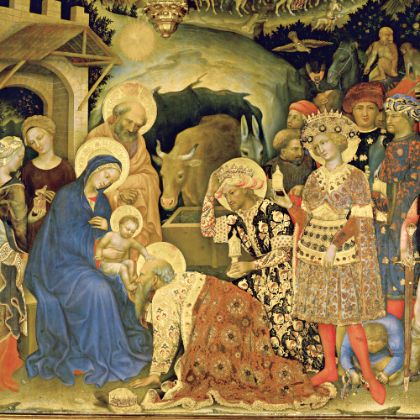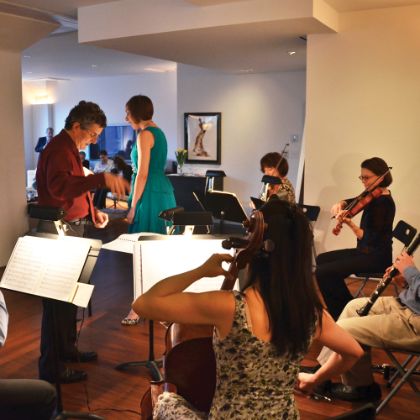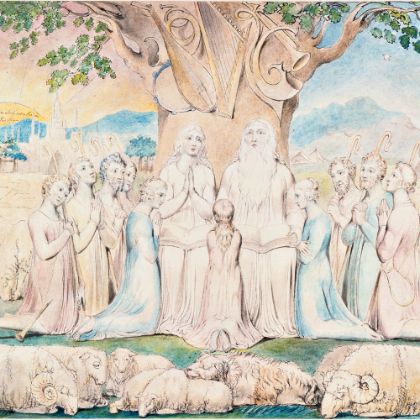The composer’s Chamber Symphony No. 2 weds harmony and dissonance.
By Menon Dwarka
Writings on Arnold Schoenberg tend to draw attention to the more notorious or controversial aspects of his music. Yes, he was one of the first composers to write what we continue to refer to as atonal music, and he also created the rather unfortunately named “Method of Composing with Twelve Tones Which are Related Only with One Another,” but his work tends to be examined in a wholly different manner than other composers’. Questions of style, mood, intent and execution rarely find their way into non-technical discussions of his music, with focus leaning to the more shocking elements of a particular work or his period of development. And while musicologists and theorists are amply equipped to discuss the substance of his music in a more thorough way, there is often a disconnect between the material and expression, or more plainly put, how the building blocks of music contribute to the larger “meaning” of a work. His more benign scores inhabit a virtual no-man’s-land with critics and performers alike: too conservative or backwards-looking to fit into the narrative of an avant-garde artist, and yet somehow still too obtuse for those who judge music on some arbitrary scale of feeling or emotion. These views have marred the reception of Schoenberg’s Chamber Symphony No. 2, an approachable but no less serious artistic statement than the composer’s contemporaneous twelve-tone works.
Schoenberg, who usually composed with blistering speed, began this work in 1906 and didn’t finish it until 1939. One might think that world events leading up to World War II may have contributed to this long gestation period; in fact, the war may have acted as the catalyst for the work’s completion.
When rising anti-Semitism in Germany resulted in the barring of Schoenberg’s reappointment at the Prussian Academy of the Arts, he and his family fled to the United States in 1933, stopping briefly in Paris to reconvert to Judaism (with Marc Chagall at their side). As with many other émigré composers, Schoenberg had trouble finding his professional footing in the New World. After stops in Boston, New York and Chautauqua, he finally settled in Los Angeles, where he began teaching at the University of Southern California.
Safe from harm’s way in America but unable to help his friends and family from the oncoming horrors of the Nazis, Schoenberg seemed to suffer from artistic paralysis. No new music flowed from his pen. And yet his restless mind yearned to attack the problems of musical composition.
Rather than arrange the works of another composer, a practice common among composers when they seek inspiration, Schoenberg spent a significant amount of energy “re-composing” works of the Baroque period. The Concerto for Violoncello and Orchestra in D major and the Concerto for String Quartet and Orchestra in B major, both from 1933, are listed in Schoenberg’s oeuvre as “free adaptations” of the work of Monn and Handel, respectively. In both of these cases, Schoenberg’s approach was unique, maintaining surface materials (themes, formal proportions, etc.) but applying modern approaches to harmony, polyphony and orchestration. Coincidentally, both of these works were the result of commissions, the Cello Concerto coming from the great virtuoso Pablo Casals. Sadly, there is no evidence that he ever performed the work publicly.
In 1935 Schoenberg turned his hand towards arranging for large orchestra his Chamber Symphony No. 1, Op. 9, from 1906. It had been one of the most important works in his development as a composer. Prior to Op. 9, Schoenberg had been on a trajectory largely determined by the music of his youth. For all his trailblazing in post-tonal and twelve-tone music, we often forget that Schoenberg was born in 1874, when Brahms, Wagner, Bruckner and Richard Strauss were all active; Mahler would start making his mark ten years later. Composers of Schoenberg’s generation tended to follow the Neudeutsche Schule, with its predilection for distant harmonic modulations and expansive, sprawling themes, all of which were pushing traditional musical forms beyond the dimensions for which they were designed. Schoenberg’s tone poem Pelleas und Melisande was a single-movement orchestral work that lasted nearly fifty-five minutes. His String Quartet in D minor, Op. 7, was of similar proportions, but included even more daring modulations, stating the main theme in C-sharp minor and E-flat minor within minutes of the work’s opening. Taking for granted the sheer awe of hearing musical textures presented over such large expanses of time, most composers, including Schoenberg, felt they needed to work at this scale because they were still clinging to certain conceits of musical comprehensibility. But if Western music was to keep developing, it seemed less and less likely that the answer would be found in going bigger.
In a nutshell, the more remote the thematic derivations or harmonic modulations, the more time it would take a listener to follow the transitions between point A and point B. Move from C major to F-sharp major, a distant modulation by any account, and you stand to lose the listener if you don’t make some pit stops along the way. But what if the comfort of your listener wasn’t your highest priority? What if those well-padded transitions became a distraction from the harmonic or thematic juxtaposition of distantly related material? Schoenberg’s Op. 9 became the testing ground for this approach.
‘A longing to return to the old style was always powerful in me; and I was forced to yield to that urge from time to time.’’
Taut, nimble and concise, the Chamber Symphony No. 1, completed in 1906, compressed the material of a four-movement symphony into a twenty-minute work, colliding themes and harmonies in a raucous display of Schoenberg’s new aesthetic. He had forged a new style where almost anything seemed possible, including the use of unprepared dissonant harmonies. If there were any miscalculations, it was not realizing that the internal pressures of forcing music of great power and scope into such a small temporal space would shake the very foundations of tonality.
Schoenberg is said to have begun work on his Chamber Symphony No. 2 the day he completed the first, but he ultimately abandoned these sketches in favor of creating a new sound world based on the harmonic implications of Op. 9 — what we now refer to as atonal music.
Confronting the material of this work after many years and many miles of travel seems to have reawakened Schoenberg’s adventurous spirit. Following the arrangement of Op. 9 for large orchestra, Schoenberg completed two large-scale twelve-tone works in 1936: the Concerto for Violin and Orchestra and his Fourth String Quartet.
Having completed two tonal concertos and two dodecaphonic pieces since arriving in the U.S., Schoenberg could have continued in either direction. Instead, he chose to finish the Chamber Symphony No. 2. Despite being another commissioned work, Schoenberg seized the opportunity to bring both of his worlds together, chiefly by superimposing motives and figures that one might find in a non-tonal work onto a tonal work and softening the dissonances through maximally smooth voice-leading and ever-shifting harmonizations. I’ve often wondered if this approach didn’t mirror Schoenberg’s own experience of being caught between two worlds — the Old and the New, Europe and America. Even the formal elements of the work’s two movements seem to reflect Schoenberg’s personal history. The dark, somber strains of the first movement seem to mirror Schoenberg’s state of mind when he was forced to leave his homeland. The ebullient, almost giddy start to the second movement slowly gives way to the return of the work’s opening measures, almost as if the joy he felt in finding a home in America couldn’t block out his premonition of the events in Europe of 1939.
Speaking to his tonal works, which included Chamber Symphony No. 2, Schoenberg said: “A longing to return to the old style was always powerful in me; and I was forced to yield to that urge from time to time. So sometimes I compose tonal music. Stylistic differences of this kind have no special importance for me. I don’t know which of my compositions are better; I like them all, because I liked them when I was writing them.”

Photos: Arnold Schoenberg Institute/Leb/Lebrecht Music & Arts
-

From Christemasse to Carole
The birth of Christmas in medieval England
Read More
By David Vernier -

The Next (Not-So-)Big Thing
New chamber orchestras are popping up all over America.
Read More
By Colin Eatock -

A Father's Lament
Finding solace in the sound of authentic sorrow
Read More
By Rev. Jake Bohstedt Morrill